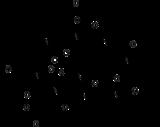
Beta-amanitin
Encyclopedia
beta-Amanitin or β-amanitin is a cyclic
peptide
of eight amino acid
s. It is an amatoxin
, a group of toxin
s isolated from and found in several members of the Amanita
genus of mushroom
s, one being the Death cap (Amanita phalloides) as well as the Destroying angel
, a complex of similar species, principally A. virosa
and A. bisporigera
.
Cyclic compound
In chemistry, a cyclic compound is a compound in which a series of atoms is connected to form a loop or ring.While the vast majority of cyclic compounds are organic, a few inorganic substances form cyclic compounds as well, including sulfur, silanes, phosphanes, phosphoric acid, and triboric acid. ...
peptide
Peptide
Peptides are short polymers of amino acid monomers linked by peptide bonds. They are distinguished from proteins on the basis of size, typically containing less than 50 monomer units. The shortest peptides are dipeptides, consisting of two amino acids joined by a single peptide bond...
of eight amino acid
Amino acid
Amino acids are molecules containing an amine group, a carboxylic acid group and a side-chain that varies between different amino acids. The key elements of an amino acid are carbon, hydrogen, oxygen, and nitrogen...
s. It is an amatoxin
Amatoxin
Amatoxins are a subgroup of at least eight toxic compounds found in several genera of poisonous mushrooms, most notably Amanita phalloides and several other members of the genus Amanita, as well as some Conocybe, Galerina and Lepiota mushroom species.-Structure:The compounds have a similar...
, a group of toxin
Toxin
A toxin is a poisonous substance produced within living cells or organisms; man-made substances created by artificial processes are thus excluded...
s isolated from and found in several members of the Amanita
Amanita
The genus Amanita contains about 600 species of agarics including some of the most toxic known mushrooms found worldwide. This genus is responsible for approximately 95% of the fatalities resulting from mushroom poisoning, with the death cap accounting for about 50% on its own...
genus of mushroom
Mushroom
A mushroom is the fleshy, spore-bearing fruiting body of a fungus, typically produced above ground on soil or on its food source. The standard for the name "mushroom" is the cultivated white button mushroom, Agaricus bisporus; hence the word "mushroom" is most often applied to those fungi that...
s, one being the Death cap (Amanita phalloides) as well as the Destroying angel
Destroying angel
The name destroying angel applies to several similar, closely related species of deadly all-white mushrooms in the genus Amanita. They are Amanita bisporigera and A. ocreata in eastern and western North America, and A. virosa in Europe. Another very similar species, A. verna or fool's mushroom was...
, a complex of similar species, principally A. virosa
Amanita virosa
Amanita virosa, commonly known as the European destroying angel, is a deadly poisonous basidiomycete fungus, one of many in the genus Amanita. Occurring in Europe, A. virosa associates with various deciduous and coniferous trees...
and A. bisporigera
Amanita bisporigera
Amanita bisporigera is a deadly poisonous species of fungus in the Amanitaceae family. It is commonly known as the eastern North American destroying angel or the destroying angel, although it shares this latter name with three other lethal white Amanita species, A. ocreata, A. verna and...
.
See also
- Mushroom poisoningMushroom poisoningMushroom poisoning refers to harmful effects from ingestion of toxic substances present in a mushroom. These symptoms can vary from slight gastrointestinal discomfort to death. The toxins present are secondary metabolites produced in specific biochemical pathways in the fungal cells...

